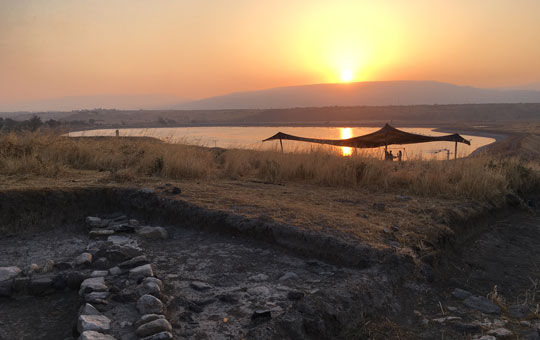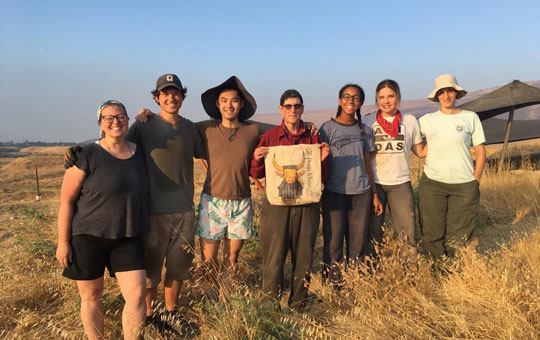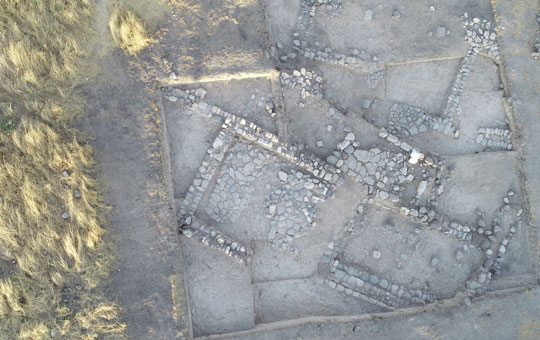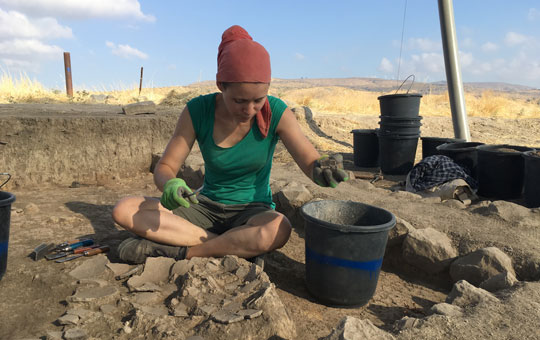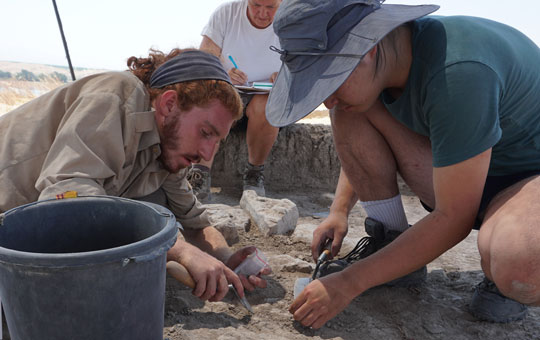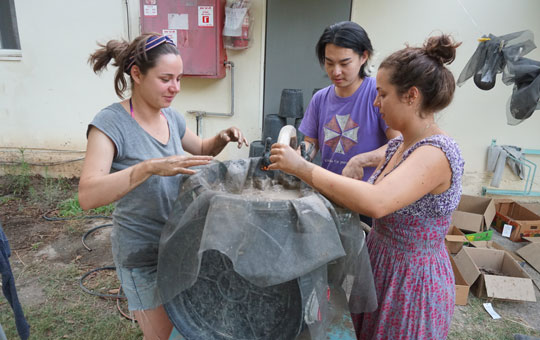Tel Yaqush Research and Excavation Project
Curatorial Section
Research Discipline
Archaeology
Expand Global Research
Over more than a century, we’ve opened up endless exploration across six continents. New field work endowments will ensure our continued leadership in national and international field research and discovery.
Give Now- Time Period Studied
-
The ancient settlement at Tel Yaqush was occupied for more than 1000 years, throughout the Early Bronze Age (3700-2500 BCE). The excavation focuses on the different phases of this period (namely Early Bronze Age I-III), which were exposed in various parts of the site.
- Location Information
-
Tel Yaqush is situated in the Jordan Valley (Israel), about seven miles south of the Sea of Galilee and eight miles north of Tel Beth-Shean, excavated in the 1920’s-1930’s by the Penn Museum. The site is located next to the outlet of the Tabor stream into the Jordan River, facing the Jordan River to its east and backed by the dominating heights of the eastern Lower Galilee mountains to its west. It is easily accessed by a short dirt road, which exits off the main north-south road, Route 90, next to the modern Kibbutz Gesher.
- Researcher(s)
-
- Dr. Mitchell Rothman, Consulting Scholar, Penn Museum
- Dr. Yael Rotem, Consulting Scholar, Penn Museum and post-doctoral researcher at Recanati Institute for Maritime Studies, University of Haifa
- Dr. Mark Iserlis, Post-Doctoral Researcher, German Archaeological Institute, Berlin.
- Team Members
-
Penn Museum Team Members: Katy Blanchard (Registrar and office manager), Chantel White (Archaeobotanist)
Supervisors and Staff: Nadia Bladt Knudsen (Tel Aviv University, TAU), Hanna Erftenbeck (Notre Dame University), Laurin Stöckert (Ludwig-Maximilians Universität München), Malte Loetz (Freie Universität Berlin), Katharina Kellner (Georg-August-Universität Göttingen), Gwendoline Maurer (Archaeozoologist, Environmental analysis supervisor, UCL), Mariana Ribas (Environmental analysis supervisor, UCL), Kyrill Radezky (Restorer, Berlin), Julian Hirsch (Area supervisor assistant, Oberlin College)
- Project Summary
-
Tel Yaqush was occupied during one of the most dynamic millennia in world history, when the first states were evolving in neighboring greater Mesopotamia and Egypt.
Its size (about 2.5 hectares) and the results of earlier excavations by the Oriental Institute (University of Chicago) indicate that the village of Tel Yaqush was likely within the sphere of influence of Tel Bet Yerah, a 30-hectare walled center on the shores of the Sea of Galilee. It shares similar material culture with the Early Bronze Age village at Tel Beth-Shean, initially excavated by the Penn Museum.
The excellent preservation of Yaqush village and its occupation throughout the entire Early Bronze Age offer an opportunity to explore the major social and political changes taking place in this region over time, particularly relating to urbanization and migration.
In the Early Bronze Age, the first fortified cities were being constructed in the Southern Levant. These cities established a new form of political organization and created a centrally controlled economy. Yaqush, however, remained a small, unfortified village, in the shadow of the large city of Bet Yerah. The renewed excavations focus on the evolution of the village and its’ relations with other sites in its’ vicinity, in this dramatic shift to urbanism in the region.
This period is also marked by the large-scale movement of people throughout the Middle East. Material associated with the so-called Kura-Araxes culture, which originated in the Southern Caucasus, has been found at Tel Yaqush, making it one of the southernmost sites this group occupied. Study of the distinctive material cultural of the Kura-Araxes newcomers found at Yaqush sheds light on their arrival and integration with local populations.
Project co-directors launched the field project at Tel Yaqush in the summer of 2018, with plans for five excavation seasons and two study seasons. Two seasons conducted so far (2018-2019) included students and staff from the US, Germany, the UK, Netherlands, Switzerland, Hungary and Israel. In addition to gaining first-hand experience in excavation, students participating in the dig learn from afternoon talks and lectures, and have opportunities to travel to other archaeological and historical sites in Israel.
- Additional Sponsors
-
No experience necessary!
Contact Dr. Yael Rotem - Resources & More Information
-
To keep up with the latest updates, follow Tel Yaqush Excavations on Facebook
Yael Rotem, Mark Iserlis, Ariel Rosenblum & Mitchell S. Rothman (2021): A Late 4th millennium BCE cylinder-seal amulet from Tel Yaqush and its contribution to the understanding of EB I–II communities in the Central Jordan Valley, Levant, DOI: 10.1080/00758914.2021.1926723
University of Chicago excavations at Tel Yaqush
Rotem, Y., Iserlis, M., Höflmayer, F., and Rowan, Y. (2019), Tel Yaqush – An Early Bronze Age Village in the Central Jordan Valley, Israel. Bulletin of the American Schools of Oriental Research 381:107-144.
As the first states were emerging in Mesopotamia and Egypt, major social and political changes were taking place in the Levant. The Tel Yaqush Research and Excavation Project focuses on the Early Bronze Age (ca. 3700-2500 BCE) village of Tel Yaqush, located in the Jordan Valley (Israel), and explores migration and the rise of urbanism in this dynamic region.
Are you a Penn Student interested in participating in the excavation?
People Associations
